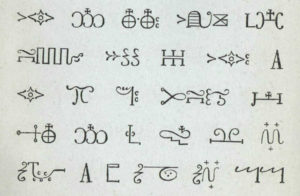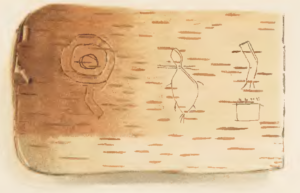Like with the elephants [Mastodons], the Smithsonian experts are sure no tribe in America had a written language, ever:
…whenever an alphabet of any kind is veritably discovered, it must have had a foreign origin. By granting belief to anything contravening this state of art, we at first deceive ourselves, and then lend our influence to diffuse error. – Schoolcraft (John Campbell “The Ancient Literature of America,” Proceedings and Transactions of the Royal Society of Canada, Second Series, Vol. II, 1896, pp. 47)
Evidences:
- “Characters” copied from the gold plates
- The Ancient Literature of America by John Campbell, LLD – 1896
- Ancient Man in America Including Works in Western New York and Portions of Other States, by Frederick Larkin, M.D. – 1880
Miꞌkmaq

Miꞌkmaq hieroglyphic writing was a writing system and memory aid used by the Miꞌkmaq, a First Nations people of the east coast of Canada (“Miꞌkmaq hieroglyphic writing,” Wikipedia, https://en.wikipedia.org/wiki/Mi%EA%9E%8Ckmaq_hieroglyphic_writing).
Ojibwe

Ojibwe is an indigenous language of North America from the Algonquian language family. Ojibwe is one of the largest Native American languages north of Mexico in terms of number of speakers and is characterized by a series of dialects, some of which differ significantly. The dialects of Ojibwe are spoken in Canada from southwestern Quebec, through Ontario, Manitoba and parts of Saskatchewan, with outlying communities in Alberta and British Columbia, and in the United States from Michigan through Wisconsin and Minnesota, with a number of communities in North Dakota and Montana, as well as migrant groups in Kansas and Oklahoma (“Ojibwe writing systems,” Wikipedia, https://en.wikipedia.org/wiki/Ojibwe_writing_systems; see also Ojibwe People’s Dictionary)
To admit that even a single tribe in North America had a written language would upset established thought.